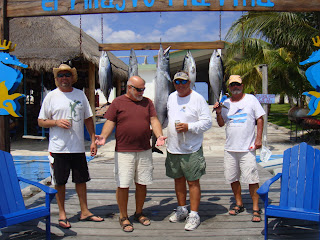 |
| The start of a perfect day! |
This retired life is hard, however, with some careful planning, I figured I could squeeze a little fishing into my busy schedule.
We met at the dock at 8:00 a.m., four of us, Charlie, Dave Waddell, Brent Kraushar, and me.
It took us about twenty minutes to load the gear, ice, bait, beer, and sandwiches, and we were off.
Charlie has a Grady White 30-foot fishing machine, all set up for multiple rods and downriggers.
It’s the ultimate guy-toy.
The day was perfect, sunshine, calm turquoise waters and good friends to have a laugh with. The trip took us about an hour to get to the area where we were going to fish. It is an underwater plateau about twenty-five miles offshore called Arrowsmith.
And no, you can’t see land from anywhere around there, but the boat has some pretty sophisticated electronics, so we knew exactly where we were. Once all six lines were in the water, we decided to have a breakfast beer.
Fifteen minutes later, we hooked our first fish, a really nice Blackfin Tuna, and now it’s time for another celebratory beer. Charlie decided to circle around with our troll, just in case this fish had friends and relatives in the area. And yes, he did! Lots of friends!
We stayed in the same one-mile area all day and caught eight more big tunas. What a haul. Good eating!
Late in the day, it was time to head back to the dock, clean up a bit and hit the Soggy Peso Bar for a few more celebratory beers and lots of fishing stories.
Charlie has a Grady White 30-foot fishing machine, all set up for multiple rods and downriggers.
It’s the ultimate guy-toy.
 |
| The perfect day |
And no, you can’t see land from anywhere around there, but the boat has some pretty sophisticated electronics, so we knew exactly where we were. Once all six lines were in the water, we decided to have a breakfast beer.
 |
| Great fishing today |
Fifteen minutes later, we hooked our first fish, a really nice Blackfin Tuna, and now it’s time for another celebratory beer. Charlie decided to circle around with our troll, just in case this fish had friends and relatives in the area. And yes, he did! Lots of friends!
We stayed in the same one-mile area all day and caught eight more big tunas. What a haul. Good eating!
Late in the day, it was time to head back to the dock, clean up a bit and hit the Soggy Peso Bar for a few more celebratory beers and lots of fishing stories.
 |
| The fish stories start, Brent, Lawrie, Dave, Charlie |
It was a truly fine day in paradise.
Hasta luego, Lawrie
Grab your copy today!
Or


%20Instagram%20%231.jpg)




















